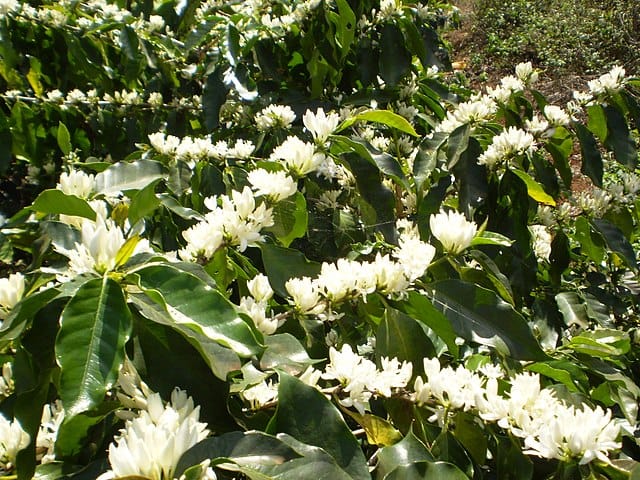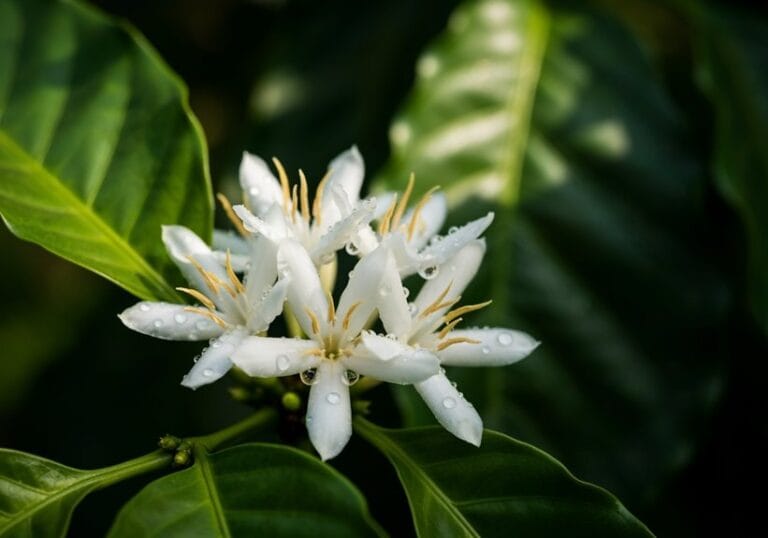The coffee flower is this stunningly delicate bloom that looks like a tiny star and smells divine—like jasmine’s cousin who got into a fancy perfume! It pops up before those lovely coffee cherries we love so much. These blooms not only make our coffee dreams possible but also help farmers earn their keep! Can you believe they even attract bees, enhancing yields by 20%? So, while the flowers are fleeting, they pack a punch in importance—don’t you just love that irony? Stick around, and you’ll uncover more of these flowery wonders!
Key Takeaways
- Coffee flowers are star-shaped and fragrant blooms that last just a couple of days, signaling the start of the coffee cherry development.
- They attract pollinators, enhancing cross-pollination and increasing coffee yield by approximately 20%.
- The blooming period occurs 3-4 years after planting, typically from September to November, lasting 2-3 months.
- Coffee flowers are economically significant as they directly influence income for over 125 million coffee-dependent individuals globally.
- Culturally, they symbolize hope and prosperity, bringing communities together in anticipation of the upcoming harvest season.
Botanical Characteristics of Coffee Flowers
When you think about coffee, you probably picture rich brown beans, steaming cups of joe, or maybe even the delightful buzz that comes from your initial sip.
But hold up! Don’t forget the unsung hero of that caffeine journey: the coffee plant flower! These delicate, star-shaped blooms, which resemble tiny jasmine and smell divine, sprout in clusters—like nature’s miniature fireworks in your garden.
They only stick around for a couple of days, which is kind of rude, right? Each flower packs reproductive goodies, five stamens ready to party, and an ovary housing two precious ovules. Arabica coffee flowers are self-pollinating while they bloom in the early morning sun, proving that even flowers can’t get enough of a good morning!
Role of Coffee Flowers in Plant Lifecycle
Coffee flowers are like the opening act of a show that nobody knew they needed—just a few delicate days in the spotlight before the real star, the coffee cherry, takes the stage.
These charming blooms in the coffee family start their magic around three to four years after planting, usually between September and November, depending on the weather.
It’s a short gig, lasting just two to three months, but oh, what a vital role they play! They open up, releasing pollen, and inviting pollinators to do their thing.
It’s like a dating game out there—cross-pollination is key! More flowers mean more potential coffee cherries, which means your morning brew is on the way.
Who knew flowers could be so important?
Economic and Cultural Significance of Coffee Flowers

Amazement fills the air as coffee flowers sprinkle hope like confetti during the growing season! This flower of coffee isn’t just eye candy; it’s the backbone of farmer income, folks!
More flowers mean more cherries, which means bigger paychecks. Can you believe that over 125 million people globally rely on coffee? That’s like an entire country depending on these delicate blooms!
And let’s not forget, when bees do their buzzing magic, it enhances yields by about 20%. Talk about teamwork, right?
Plus, the timing of these flowers adds a dash of excitement to village life—everyone gets ready to celebrate harvest season!
Frequently Asked Questions
How Do Coffee Flowers Contribute to Coffee Flavor Profiles?
Coffee flowers considerably improve flavor profiles through their aromatic contributions, offering floral notes reminiscent of lilac and jasmine. These scents influence the total sensory experience, primarily perceived during the coffee’s aroma rather than its taste.
Can Coffee Flowers Be Used in Cosmetics or Fragrances?
Coffee flowers can indeed be used in cosmetics and fragrances, offering antiseptic and antioxidant properties while contributing a delicate aroma. Their unique scent enriches luxury products, making them sought after in skincare and perfume formulations.
Are Coffee Flowers Edible or Safe for Consumption?
Coffee flowers are generally considered non-toxic and lower in caffeine but are not widely documented as safe for human consumption. Caution is advised, and traditional knowledge should be consulted before using them in culinary practices.
How Long Do Coffee Plants Typically Bloom Each Year?
Coffee plants typically bloom for approximately two to three months each year. This period may vary, influenced by climatic conditions. Flowering usually occurs once or twice annually, closely following seasonal rains that trigger the flowering process.
What Pests or Diseases Affect Coffee Flowers?
Coffee flowers are affected by pests such as mealybugs and the coffee berry borer, in addition to diseases like Coffee Leaf Rust and Anthracnose, which can greatly impair plant health and reduce yield quality.
References
- https://edis.ifas.ufl.edu/publication/FP135
- https://en.wikipedia.org/wiki/Coffea
- https://plants.ces.ncsu.edu/plants/coffea-arabica/
- https://www.britannica.com/plant/Coffea
- https://greenhouse.biology.indiana.edu/features/crops/Coffea-arabica.html
- https://www.missouribotanicalgarden.org/PlantFinder/PlantFinderDetails.aspx?kempercode=b632

